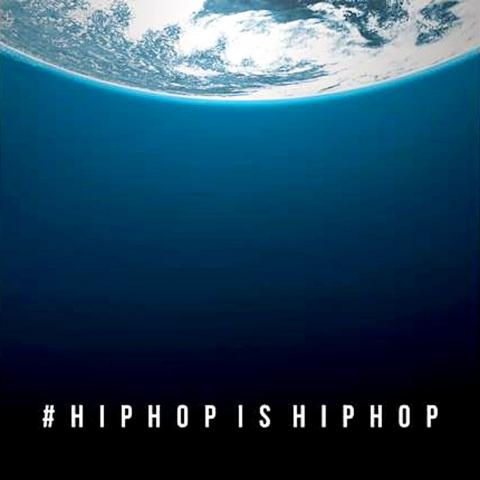With his streak of bleached blonde hair, designer hip-hop clothing apparel and an altogether easy-going and affable demeanor, Mr. Skin (賴皮) isn’t what you would expect from someone who just represented Taiwan as part of the collective known as Hip Hop for the World, which recently released a global anthem for the UN’s International Children’s Emergency Fund (UNICEF).
In the new charity single, #HIPHOPISHIPHOP, musicians from 14 different nations gathered together to celebrate hip-hop as a universal language that bridges languages, cultures and nations, with all sales of the going to UNICEF.
The collaboration places Mr. Skin, first among equals among the global hip-hop community. It also places a Taiwanese national on an equal footing with American, British and South Korean nationals participating in the project. It is a breakthrough for Taiwanese artists who are often grouped together with China in the global music scene.

Photo courtesy of Mr Skin
HIP-HOP ARTISTS OF THE WORLD UNITE!
Mr. Skin’s role as ambassador of Taiwan hip-hop didn’t happen overnight, as he’s been involved in Taiwan’s hip-hop scene for over a decade, starting his career as a club DJ.
He became interested in MC-ing after composing his own rhymes and uploading his compositions to influential music Web site StreetVoice.com, which has been instrumental in helping underground musicians promote their own recordings. He met other like-minded musicians on the site, and went on to found the Taiwan hip-hop collective Juzzy Orange (汁橙音樂).

Photos courtesy of Mr Skin
It was Mr. Skin’s reputation cultivated on the Internet that brought him to the attention of South Korean hip-hop superstar San-E, who reached out to him about taking part in the collaboration. Mr. Skin asked San-E’s organizers how they discovered him, in which they responded “Wikipedia.”
Inspired by the 1985 hit-song We are the World, which saw an all-star lineup of American musicians crooning for relief funds for Africa, #HIPHOPISHIPHOP features hip-hop musicians from Indonesia, Egypt, Portugal and Finland. Rounding out the international crew with a little star power is American hip-hop legend, KRS-One.
“I think most of my friends were shocked that I was able to be part of a collaboration with KRS-One. They didn’t really think about what it meant for a Taiwanese hip-hop artist to take part in this kind of project,” he said.
Mr. Skin credits San-E for realizing the project and donating all proceeds of the song to UNICEF.
“None of us knew each other before we started working on this track. It’s amazing that San-E’s crew was able to coordinate so many artists on this project,” he said.
A SHOUT-OUT TO TAIWAN
On the 7-minute track, each hip-hop artists raps and rhymes in his or her own respective language. The music video for #HIPHOPISHIPHOP features the artists rapping against backdrops of their respective hometowns and countries.
Mr. Skin raps in Mandarin to a jazz-horn rhythm section and a pulsing electric beat, scenes of Kaohsiung’s harbor front and the iconic Tuntex Sky Tower loom large in the background.
As each musician is introduced, an image of the national flag floods the screen as a representation of his or her nationality. As Mr. Skin appears in the video, Taiwan’s Republic of China canton appears alongside him, putting him next to a flag that is rarely seen outside of Taiwan’s borders.
Some Taiwanese musicians are hesitant to express their support for Taiwan as a separate nation for fear of losing out on record deals and concert opportunities in China. In one famous instance, Taiwanese pop sensation A-Mei (張惠妹) was famously blacklisted from performing in China for a number of years because of her choice to sing at former president Chen Shui-bian’s (陳水扁) 2000 inauguration ceremony.
Mr. Skin seemed surprised when asked about the impact a Taiwanese artist would have participating in a project that recognizes Taiwan.
“This isn’t a China thing, a [Republic of China] R.O.C. thing, or a Chinese, Taipei thing,” said the Kaohsiung-based DJ and MC, whose real name is Lai Chun-hung (賴重宏). “I participated in this project representing for Taiwan.”
“If you ask a rapper like Dwagie (大支), his stand is very clear. I represent Taiwan. If you think Taiwan is part of China, then “fuck you,” I want nothing to do with you,” he said.
I then asked what he felt about Taiwanese musicians leaving their identity and nationality at the door when performing in China.
He expressed no hard feelings to artists who make the choice to drop their national identity while in China, but is resolute in his own thinking.
“For me it comes down to this. China is China, Taiwan is Taiwan. If you want to go to China to go to China and make money, good for you man,” he said.

May 26 to June 1 When the Qing Dynasty first took control over many parts of Taiwan in 1684, it roughly continued the Kingdom of Tungning’s administrative borders (see below), setting up one prefecture and three counties. The actual area of control covered today’s Chiayi, Tainan and Kaohsiung. The administrative center was in Taiwan Prefecture, in today’s Tainan. But as Han settlement expanded and due to rebellions and other international incidents, the administrative units became more complex. By the time Taiwan became a province of the Qing in 1887, there were three prefectures, eleven counties, three subprefectures and one directly-administered prefecture, with

It’s an enormous dome of colorful glass, something between the Sistine Chapel and a Marc Chagall fresco. And yet, it’s just a subway station. Formosa Boulevard is the heart of Kaohsiung’s mass transit system. In metro terms, it’s modest: the only transfer station in a network with just two lines. But it’s a landmark nonetheless: a civic space that serves as much more than a point of transit. On a hot Sunday, the corridors and vast halls are filled with a market selling everything from second-hand clothes to toys and house decorations. It’s just one of the many events the station hosts,

Among Thailand’s Chinese Nationalist Party (KMT) villages, a certain rivalry exists between Arunothai, the largest of these villages, and Mae Salong, which is currently the most prosperous. Historically, the rivalry stems from a split in KMT military factions in the early 1960s, which divided command and opium territories after Chiang Kai-shek (蔣介石) cut off open support in 1961 due to international pressure (see part two, “The KMT opium lords of the Golden Triangle,” on May 20). But today this rivalry manifests as a different kind of split, with Arunothai leading a pro-China faction and Mae Salong staunchly aligned to Taiwan.

Two moves show Taichung Mayor Lu Shiow-yen (盧秀燕) is gunning for Chinese Nationalist Party (KMT) party chair and the 2028 presidential election. Technically, these are not yet “officially” official, but by the rules of Taiwan politics, she is now on the dance floor. Earlier this month Lu confirmed in an interview in Japan’s Nikkei that she was considering running for KMT chair. This is not new news, but according to reports from her camp she previously was still considering the case for and against running. By choosing a respected, international news outlet, she declared it to the world. While the outside world